Engage NY Eureka Math 3rd Grade Module 5 Lesson 18 Answer Key
Eureka Math Grade 3 Module 5 Lesson 18 Problem Set Answer Key
Place the two fractions on the number line. Circle the fraction with the distance closest to 0. Then, compare using >, <, or =. The first problem is done for you.
Question 1.

Explanation :
Number line is divided into 4 as the denominator of the numbers is 4 .
Fractional Numbers are represented on the number line and number is which is closest to 0 is circled is shown in the above figure .
\(\frac{1}{4}\) < \(\frac{3}{4}\)
Question 2.

Answer:
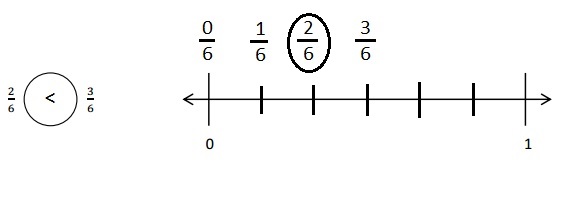
Explanation :
Number line is divided into 6 as the denominator of the numbers is 6 .
Fractional Numbers are represented on the number line and number is which is closest to 0 is circled is shown in the above figure .
\(\frac{2}{6}\) < \(\frac{3}{6}\)
Question 3.

Answer:

Explanation :
Number line is divided into 4 as the denominator of the numbers is 4 .
Fractional Numbers are represented on the number line and number is which is closest to 0 is circled is shown in the above figure .
\(\frac{1}{2}\) > \(\frac{1}{4}\)
Question 4.

Answer:
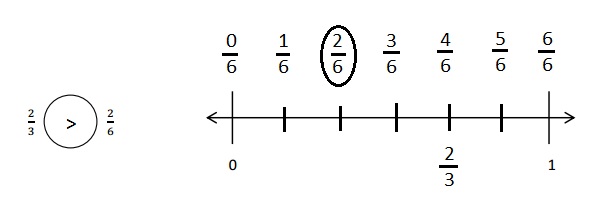
Explanation :
Number line is divided into 6 parts as the denominator of the numbers is 6 .
Fractional Numbers are represented on the number line and number is which is closest to 0 is circled is shown in the above figure .
\(\frac{2}{3}\) > \(\frac{2}{6}\)
Question 5.

Answer:

Explanation :
Number line is divided into 8 parts as the denominator of the numbers is 8 .
Fractional Numbers are represented on the number line and number is which is closest to 0 is circled is shown in the above figure .
\(\frac{11}{8}\) < \(\frac{7}{4}\)
Question 6.
JoAnn and Lupe live straight down the street from their school. JoAnn walks \(\frac{5}{6}\) miles and Lupe walks \(\frac{7}{8}\) miles home from school every day. Draw a number line to model how far each girl walks. Who walks the least? Explain how you know using pictures, numbers, and words.
Answer:

Explanation :
Distance from Joann Home to School = \(\frac{5}{6}\)
Distance from Lupe home to School = \(\frac{7}{8}\)
\(\frac{7}{8}\) is greater than \(\frac{5}{6}\)
so, \(\frac{5}{6}\) is lesser than \(\frac{7}{8}\) .
Question 7.
Cheryl cuts 2 pieces of thread. The blue thread is \(\frac{5}{4}\) meters long. The red thread is \(\frac{4}{5}\) meters long. Draw a number line to model the length of each piece of thread. Which piece of thread is shorter? Explain how you know using pictures, numbers, and words.
Answer:
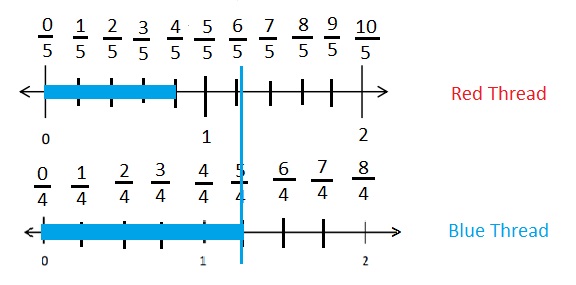
Explanation :
Length of Blue Thread = \(\frac{5}{4}\)
Length of Red Thread = \(\frac{4}{5}\)
\(\frac{5}{4}\) > \(\frac{4}{5}\)
Red Thread is shorter thread . as shown in above figure.
Question 8.
Brandon makes homemade spaghetti. He measures 3 noodles. One measures \(\frac{7}{8}\) feet, the second is \(\frac{7}{4}\) feet, and the third is \(\frac{4}{2}\) feet long. Draw a number line to model the length of each piece of spaghetti. Write a number sentence using <, >, or = to compare the pieces. Explain using pictures, numbers, and words.
Answer:

Explanation :
Length of 1st Noodle = \(\frac{7}{8}\) feet.
Length of 2nd Noodle = \(\frac{7}{4}\) feet.
Length of 3rd Noodle = \(\frac{4}{2}\) feet = 2 .
3 noodles are reprsented in the number line and a vertical Line is drawn from the longest Noodle to compare the shortest noodles as shown in above figure .
\(\frac{7}{8}\) < \(\frac{7}{4}\) < \(\frac{4}{2}\) .
Eureka Math Grade 3 Module 5 Lesson 18 Exit Ticket Answer Key
Place the two fractions on the number line. Circle the fraction with the distance closest to 0. Then, compare using >, <, or =.
Question 1.

Answer:

Explanation :
Number line is divided into 5 parts as the denominator of the numbers is 5 .
Fractional Numbers are represented on the number line and number is which is closest to 0 is circled is shown in the above figure .
\(\frac{3}{5}\) > \(\frac{1}{5}\)
Question 2.

Answer:

Explanation :
Number line is divided into 4 parts as the denominator of the numbers is 4 .
Fractional Numbers are represented on the number line and number is which is closest to 0 is circled is shown in the above figure .
\(\frac{1}{2}\) < \(\frac{3}{4}\)
Question 3.
Mr. Brady draws a fraction on the board. Ken says it’s \(\frac{2}{3}\), and Dan said it’s \(\frac{3}{2}\). Do both of these fractions mean the same thing? If not, which fraction is larger? Draw a number line to model \(\frac{2}{3}\) and \(\frac{3}{2}\). Use words, pictures, and numbers to explain your comparison.
Answer:
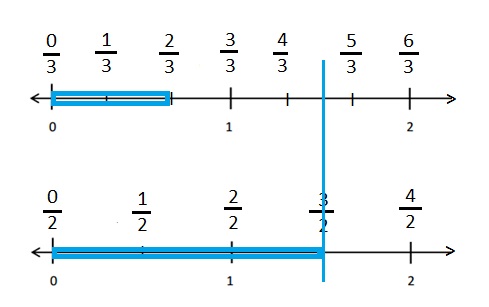
Explanation :
Fraction said by ken = \(\frac{2}{3}\),
Fraction said by Dan = \(\frac{3}{2}\)
Both the fractions are represented with different number lines and from the greater number a vertical line is drawn to show the numbers which are least as shown in above figure .
Eureka Math Grade 3 Module 5 Lesson 18 Homework Answer Key
Place the two fractions on the number line. Circle the fraction with the distance closest to 0. Then, compare using >, <, or =.
Question 1.

Answer:

Explanation :
Number line is divided into 3 parts as the denominator of the numbers is 3 .
Fractional Numbers are represented on the number line and number is which is closest to 0 is circled is shown in the above figure .
\(\frac{1}{3}\) < \(\frac{2}{3}\)
Question 2.

Answer:
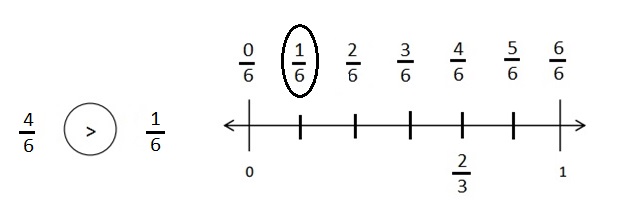
Explanation :
Number line is divided into 6 parts as the denominator of the numbers is 6 .
Fractional Numbers are represented on the number line and number is which is closest to 0 is circled is shown in the above figure .
\(\frac{4}{6}\) > \(\frac{1}{6}\)
Question 3.

Answer:

Explanation :
Number line is divided into 8 parts as the denominator of the numbers is 8 .
Fractional Numbers are represented on the number line and number is which is closest to 0 is circled is shown in the above figure .
\(\frac{1}{4}\) > \(\frac{1}{8}\)
Question 4.

Answer:

Explanation :
Number line is divided into 10 parts as the denominator of the numbers is 10 .
Fractional Numbers are represented on the number line and number is which is closest to 0 is circled is shown in the above figure .
\(\frac{4}{5}\) < \(\frac{4}{10}\)
Question 5.

Answer:

Explanation :
Number line is divided into 6 parts as the denominator of the numbers is 6 .
Fractional Numbers are represented on the number line and number is which is closest to 0 is circled is shown in the above figure .
\(\frac{8}{6}\) < \(\frac{5}{3}\)
Question 6.
Liz and Jay each have a piece of string. Liz’s string is \(\frac{4}{6}\) yards long, and Jay’s string is \(\frac{5}{7}\) yards long. Whose string is longer? Draw a number line to model the length of both strings. Explain the comparison using pictures, numbers, and words.
Answer:
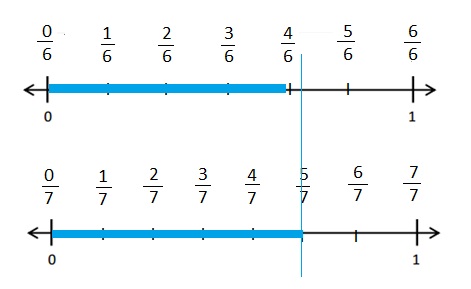
Explanation :
Length of Liz’s string = \(\frac{4}{6}\)
Length of Jay’s string = \(\frac{5}{7}\)
From the above figure we notice that \(\frac{5}{7}\) is greater than \(\frac{4}{6}\)
Question 7.
In a long jump competition, Wendy jumped \(\frac{9}{10}\) meters, and Judy jumped \(\frac{10}{9}\) meters. Draw a number line to model the distance of each girl’s long jump. Who jumped the shorter distance? Explain how you know using pictures, numbers, and words.
Answer:
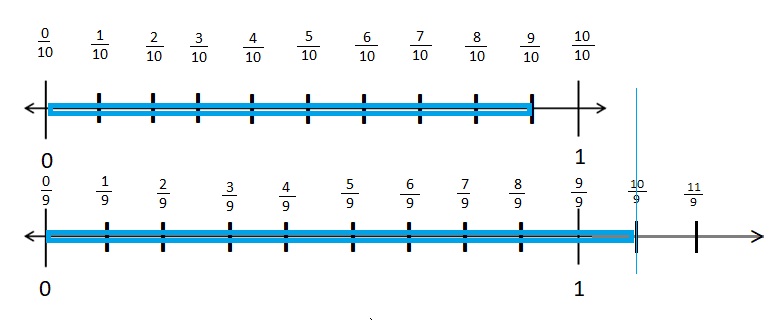
Explanation :
Distance covered by Wendy in long jump = \(\frac{9}{10}\)
Distance covered by Judy in long jump = \(\frac{10}{9}\)
From the above figure we notice that \(\frac{10}{9}\) is greater than \(\frac{9}{10}\)
Wendy jumped shorter distance .
Question 8.
Nikki has 3 pieces of yarn. The first piece is \(\frac{5}{6}\) feet long, the second piece is \(\frac{5}{3}\) feet long, and the third piece is \(\frac{3}{2}\) feet long. She wants to arrange them from the shortest to the longest. Draw a number line to model the length of each piece of yarn. Write a number sentence using <, >, or = to compare the pieces. Explain using pictures, numbers, and words.
Answer:
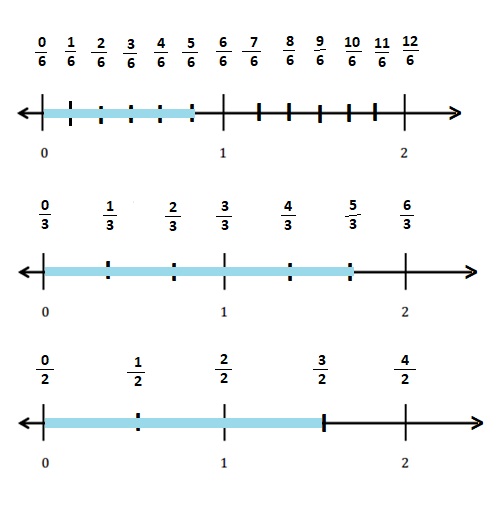
Explanation :
Length of First piece = \(\frac{5}{6}\)
Length of second piece = \(\frac{5}{3}\)
Length of third piece = \(\frac{3}{2}\)
3 Yarns are represented in number lines as shown in above figure .
\(\frac{5}{3}\) > \(\frac{3}{2}\) > \(\frac{5}{6}\) .